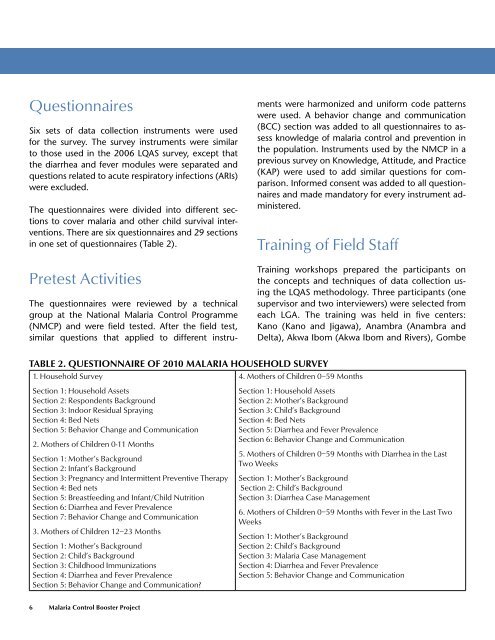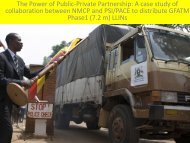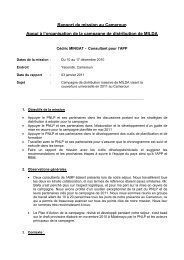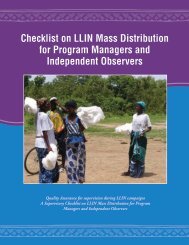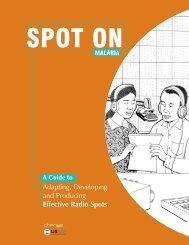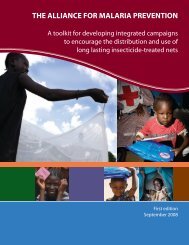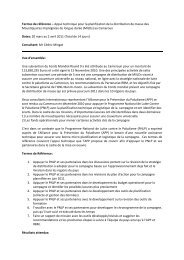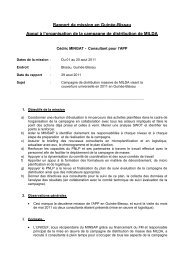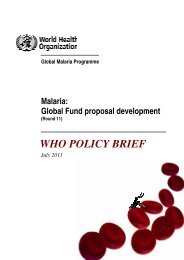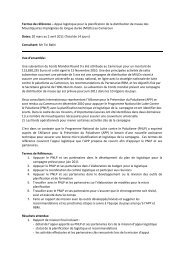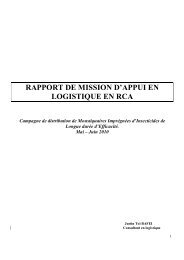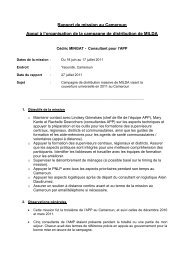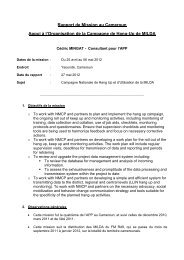R8-21_World_Bank_Nigeria_Household_Survey_2010
R8-21_World_Bank_Nigeria_Household_Survey_2010
R8-21_World_Bank_Nigeria_Household_Survey_2010
Create successful ePaper yourself
Turn your PDF publications into a flip-book with our unique Google optimized e-Paper software.
Questionnaires<br />
Six sets of data collection instruments were used<br />
for the survey. The survey instruments were similar<br />
to those used in the 2006 LQAS survey, except that<br />
the diarrhea and fever modules were separated and<br />
questions related to acute respiratory infections (ARIs)<br />
were excluded.<br />
The questionnaires were divided into different sections<br />
to cover malaria and other child survival interventions.<br />
There are six questionnaires and 29 sections<br />
in one set of questionnaires (Table 2).<br />
Pretest Activities<br />
The questionnaires were reviewed by a technical<br />
group at the National Malaria Control Programme<br />
(NMCP) and were field tested. After the field test,<br />
similar questions that applied to different instruments<br />
were harmonized and uniform code patterns<br />
were used. A behavior change and communication<br />
(BCC) section was added to all questionnaires to assess<br />
knowledge of malaria control and prevention in<br />
the population. Instruments used by the NMCP in a<br />
previous survey on Knowledge, Attitude, and Practice<br />
(KAP) were used to add similar questions for comparison.<br />
Informed consent was added to all questionnaires<br />
and made mandatory for every instrument administered.<br />
Training of Field Staff<br />
Training workshops prepared the participants on<br />
the concepts and techniques of data collection using<br />
the LQAS methodology. Three participants (one<br />
supervisor and two interviewers) were selected from<br />
each LGA. The training was held in five centers:<br />
Kano (Kano and Jigawa), Anambra (Anambra and<br />
Delta), Akwa Ibom (Akwa Ibom and Rivers), Gombe<br />
Table 2. Questionnaire of <strong>2010</strong> Malaria <strong>Household</strong> <strong>Survey</strong><br />
1. <strong>Household</strong> <strong>Survey</strong><br />
4. Mothers of Children 0–59 Months<br />
Section 1: <strong>Household</strong> Assets<br />
Section 2: Respondents Background<br />
Section 3: Indoor Residual Spraying<br />
Section 4: Bed Nets<br />
Section 5: Behavior Change and Communication<br />
2. Mothers of Children 0-11 Months<br />
Section 1: Mother’s Background<br />
Section 2: Infant’s Background<br />
Section 3: Pregnancy and Intermittent Preventive Therapy<br />
Section 4: Bed nets<br />
Section 5: Breastfeeding and Infant/Child Nutrition<br />
Section 6: Diarrhea and Fever Prevalence<br />
Section 7: Behavior Change and Communication<br />
3. Mothers of Children 12–23 Months<br />
Section 1: Mother’s Background<br />
Section 2: Child’s Background<br />
Section 3: Childhood Immunizations<br />
Section 4: Diarrhea and Fever Prevalence<br />
Section 5: Behavior Change and Communication<br />
Section 1: <strong>Household</strong> Assets<br />
Section 2: Mother’s Background<br />
Section 3: Child’s Background<br />
Section 4: Bed Nets<br />
Section 5: Diarrhea and Fever Prevalence<br />
Section 6: Behavior Change and Communication<br />
5. Mothers of Children 0–59 Months with Diarrhea in the Last<br />
Two Weeks<br />
Section 1: Mother’s Background<br />
Section 2: Child’s Background<br />
Section 3: Diarrhea Case Management<br />
6. Mothers of Children 0–59 Months with Fever in the Last Two<br />
Weeks<br />
Section 1: Mother’s Background<br />
Section 2: Child’s Background<br />
Section 3: Malaria Case Management<br />
Section 4: Diarrhea and Fever Prevalence<br />
Section 5: Behavior Change and Communication<br />
6 Malaria Control Booster Project


